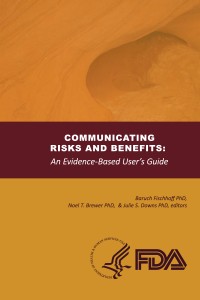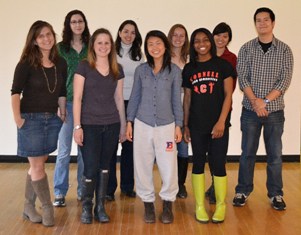By Karene Booker
Reprinted from Cornell Chronicle, October 11, 2011
From emergency evacuation notices to how many vegetables to eat, people need good information to make good choices. Ineffective risk communication, such as the drug warning inserts in tiny type on paper folded over some 12 times, can cost lives, money and reputations.
A chapter on risk communication by Valerie Reyna, professor of human development in the College of Human Ecology and co-director of Cornell's Center for Behavioral Economics and Decision Research, in a new book explains how people of different ages have different needs when it comes to understanding risk messages.
The chapter is part of the new book "Communicating Risks and Benefits: An Evidence-Based User's Guide," published by the Food and Drug Administration and freely available online. The book distills the science on health communications and provides recommendations for designing and evaluating messages. It features the work of experts at the forefront of research in medical decision-making and health communications.
"Messages that have an impact are those that are understood and remembered," said Reyna. "But cognitive processing and memory change dramatically from childhood to old age."
Effective risk communication is essential to the success of public health efforts, she said.
Research suggests that information processing and memory for details improve from childhood through young adulthood, but then gradually decline. However, the ability to remember the gist of information grows in childhood and remains strong throughout adulthood in the healthy brain. Remembering the gist of information is important because it lasts longer and is relied on to make most decisions, Reyna said. To instill the gist of a message, risk communication needs to be tailored by age.
Reyna's research suggests that children, for example, need information in simple short sentences, such as: "Eat fruits and vegetables." "Make half your plate fruits and vegetables." Such repetition will stamp these details into memory, but children will also need cues for meaning, such as "fruits and vegetables make you strong."
As children get older they will become increasingly able to connect the dots and extract the meaning of information, Reyna said. Older children, for example, will get the gist that apples, spinach, carrots and fish are healthy food, and fries, tacos, cola and cheeseburgers are generally not. Since children influence family food buying and make food choices at school, how they process risk messaging is important, Reyna said.
 Adolescents make choices about diet and exercise, sex, driving, drinking and drugs to name a few. This is also a time when many attitudes and habits about risks and benefits take root, Reyna said.
Adolescents make choices about diet and exercise, sex, driving, drinking and drugs to name a few. This is also a time when many attitudes and habits about risks and benefits take root, Reyna said.
Older adults on the other hand, face risk-benefit decisions about medications, surgical procedures and financial planning.
They need communications presented more slowly and need more memory aids due to slowing processing speed and challenges with remembering details. Written instructions, as well as alerts and reminders delivered electronically (e.g., to take medication or to signal that medication has already been taken) are likely to be helpful.
Unlike children however, older adults can rely on fairly high levels of gist knowledge. It is also essential to explain the reasons for health recommendations to them since extraction of gist is the main mechanism through which older adults remember information, Reyna said.
"To influence attitudes, values and preferences, and in turn, change behavior, the design of risk communications must take advantage of what we know about how the brain works and develops across the life span," said Reyna. "But that is just step one. We also need to use scientific methods to evaluate the effectiveness of such messages."
Karene Booker is an extension support specialist in the Department of Human Development.
Related Links:
College of Human Ecology
Valerie Reyna
Communicating Risks and Benefits - an evidence-based user's guide (PDF)







